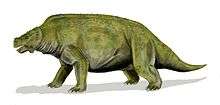Scutosaurus
| Scutosaurus Temporal range: Lopingian, 254–252 Ma | |
|---|---|
 | |
| Skeleton, American Museum of Natural History | |
| Scientific classification | |
| Kingdom: | Animalia |
| Phylum: | Chordata |
| Class: | Reptilia |
| Clade: | †Parareptilia |
| Order: | †Procolophonomorpha |
| Clade: | †Pareiasauria |
| Clade: | †Therischia |
| Genus: | †Scutosaurus Hartmann-Weinberg, 1930 |
| Species: | †S. karpinskii |
| Binomial name | |
| Scutosaurus karpinskii (Amalitzky, 1922) | |
| Synonyms | |
| |
Scutosaurus ("Shield Lizard") was a genus of Parareptiles. It was an armor-covered pareiasaur that lived around 254–252 million years ago in Russia, in the later Permian period. Its genus name refers to large plates of armor scattered across its body. It was a large anapsid reptile that, unlike most reptiles, held its legs underneath its body to support its great weight.[1]
Palaeobiology



Scutosaurus was a massively built reptile, up to 3 metres (9.8 ft) in length, with bony armor, and a number of spikes decorating its skull.[1] Despite its relatively small size, Scutosaurus was heavy, and its short legs meant that it could not move at speed for long periods of time, which made it vulnerable to attack by large predators. To defend itself Scutosaurus had a thick skeleton covered with powerful muscles, especially in the neck region. Underneath the skin were rows of hard, bony plates (scutes) that acted like a form of chain mail.
As a plant-eater living in a semi-arid climate, Scutosaurus would have wandered widely in order to find fresh foliage to eat. It may have stuck closely to the riverbanks and floodplains where plant life would have been more abundant, straying further afield only during times of drought. Its teeth were flattened and could grind away at the leaves and young branches before digesting them at length in its large gut. Given that it needed to eat constantly, Scutosaurus probably lived alone, or in very small herds, so as to avoid denuding large areas of their edible plants.
Skull
The skull is about 50 cm wide. It is very broad, flat, and strongly sculptured, and bears bony protuberances in the jugal (cheek) and rear regions. As with some species of Pareiasaurus, with which it is clearly related, the quadrato-jugal or cheekbones extend outwards and forwards, making an angle of about 120° with the maxillary border. With its large cheekbones, Scutosaurus may have been able to make a loud bellowing sound.
References
External links
- Pareiasaurinae at Palaeos